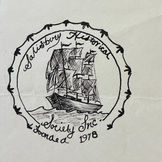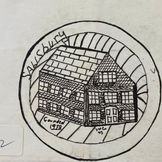
Inspire appreciation for Salisbury history.
For our full slide presentation of the "Scenes of Salisbury" quilt. . .

"Scenes of Salisbury" Quilt Squares
"Scenes of Salisbury" Quilt
If not for the steady interest and gentle influence of volunteer Judy Watson, the "Scenes of Salisbury" quilt might still be lying — slightly rumpled — on one of the beds in our small house museum. Not exactly inaccessible, but one needs to climb the steep stairway to reach the quieter spaces where you're apt to find treasures just as captivating as in the rooms on the first floor.
The "Scenes of Salisbury" Quilt was a collaborative effort undertaken as a fundraiser in 1978 by the "Women's Parish Club", a group of women connected to the East Parish Methodist Church, a religious affiliation with long-established and historic ties to the East Parish Meeting house in Salisbury Square. The quilt was subsequently raffled off, and the winner, Nicholas Sullivan (along with his wife Mary Anne) donated the quilt to the Salisbury Historical Society at its first annual meeting in October of 1978.
Of course, 1978 was not that long ago. So, why does the "SOS" quilt merit deference. . . appreciation?
The quilter-artisans were — by and large — well-known women of Salisbury who were actively engaged in their community. Their assignment was to depict significant moments of Salisbury history or salient features that are illustrative of our town’s character. Nearly all of the 42 squares contained in the roughly 7' x 8' panel have been identified as to artisan. Sadly, most — but not all — of the contributing craftswomen have since passed away. Residents who can claim generational ties to Salisbury will recognize the names (and once we start naming names, we're compelled to include all): Helen Pollard, Anna Tufts, Mildred ("Millie") Hartson, Alice Currier, Winnie Pettengill, Esther Noyes, Nina Reed, Marie Bird, Yvonne Bamford, Ellen Santos, Mary Ellen Messenger, Annie Spring, C. Taylor, Mary Eaton, Lorraine Pike, Annie Dow, Dot Hitchings, Barbara Dow, Laura Gagnon, Joyce Souliotis, Emily Pike, Shirley Weiss, Alberta Chesley, Olive Swirk, Rachel Twomey, Angie Woodard, and — enigmatically — "CM", "HJ", "AFB", and "Patterson". (Several minds worked together to identify artists who signed only their initials: we are grateful to Jan DeWitt, Arthur Ober, Bev Gulazian, resident Jim Pollard, and, of course, Judy Watson.)
Each 12” block introduces a single event on a white cotton background; nearly all are original needlepoint. (Two are a combination of commercially-prepared design with needlepoint embellishment.) The squares are separated by a border of blue-colored cotton. A slender cord for hanging the quilt was applied along the top border, but to our knowledge the quilt has never been suspended in a vertical space; instead, it has primarily been on full display, albeit with paltry results, on one of the museum’s beds. Alas, it is too big for the bed, so we have to fold it in on itself. It is, likewise, too long to place vertically on a wall. One can't help but contemplate Goldilocks with sympathy in her quest for suitable accommodations. (Our quandary, however, does have a solution.)
Although the current condition of the quilt can be described, in a preliminary way, as “good”, it had been chronically subject to dust accumulation and the effects of sunlight and artificial light, as well as handling by visitors to the museum. In other words, there was never any type of barrier to prevent such potentially harmful disturbances.
It is because of our concerns for the quilt's longevity — and not because it is currently in a fragile state, that our Board of Directors agreed to submit it — firstly — for a professional evaluation. Museum Textile Services carefully studied the quilt, and prepared a detailed report about its condition and supplied helpful recommendations for display and continued conservation. (Handing over one of our "babies" was not an easy thing to do — emotionally. Is it possible that all museum collections managers have twinges of anxiety when they "pack off" a favorite child?)
Following the evaluation, we followed the recommendation to have the quilt professionally cleaned.
The exciting phase for this project will be the subsequent plan, in which we schedule temporary displays in adequate venues in the community.
It is expected that a lot of effort will be expended in raising the necessary funds to mount the quilt in a way that assures (to the extent possible) that no further harm to it will occur. We also see as critical to the project's success the transmission of important history about Salisbury.
Due to a generous grant awarded in December by Mass Cultural Council as part of their "Festivals and Projects 2025" program, the reward will be that viewers one day soon will be able to stand in front of the "Scenes of Salisbury" quilt and not only recognize proud symbols of our town's history, but wonder about — and venerate — the women of the "Parish Women's Club" whose hands fashioned a special work of art.
Updated January 31, 2025 (originally posted December 31, 2024)
How We Chose our Organizational Logo
(A very, very brief history)
Five months after Salisbury Historical Society's first meeting, in February of 1979, members chose three finalists from the 20 submissions by Triton Regional High School art class students. On March 15, the winner's name was announced: Diane Poulin. Over four decades later, we still love our logo.
It's fun to imagine, however, if sentiments were different back then — what alternative might we have chosen. Although missing entries #1 and 19, we can present all the contestants' submissions. What would YOU have selected (or considered a finalist)?






















